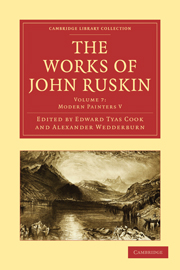Book contents
- Frontmatter
- Contents
- LIST OF ILLUSTRATIONS
- INTRODUCTION TO THIS VOLUME
- BIBLIOGRAPHICAL NOTE
- Modern Painters, Vol. V.
- PREFACE
- PART VI “OF LEAF BEAUTY”
- PART VII “OF CLOUD BEAUTY”
- PART VIII “OF IDEAS OF RELATION:—FIRST, OF INVENTION FORMAL”
- PART IX “OF IDEAS OF RELATION:—SECOND, OF INVENTION SPIRITUAL”
- CHAP. I THE DARK MIRROR
- CHAP. II THE LANCE OF PALLAS
- CHAP. III THE WINGS OF THE LION
- CHAP. IV DÜRER AND SALVATOR
- CHAP. V CLAUDE AND POUSSIN
- CHAP. VI RUBENS AND CUYP
- CHAP. VII OF VULGARITY
- CHAP. VIII WOUVERMANS AND ANGELICO
- CHAP. IX THE TWO BOYHOODS
- CHAP. X THE NEREID'S GUARD
- CHAP. XI THE HESPERID ÆGLÉ
- CHAP. XII PEACE
- EPILOGUE (1888)
- APPENDIX
- Plate section
CHAP. X - THE NEREID'S GUARD
Published online by Cambridge University Press: 07 September 2011
- Frontmatter
- Contents
- LIST OF ILLUSTRATIONS
- INTRODUCTION TO THIS VOLUME
- BIBLIOGRAPHICAL NOTE
- Modern Painters, Vol. V.
- PREFACE
- PART VI “OF LEAF BEAUTY”
- PART VII “OF CLOUD BEAUTY”
- PART VIII “OF IDEAS OF RELATION:—FIRST, OF INVENTION FORMAL”
- PART IX “OF IDEAS OF RELATION:—SECOND, OF INVENTION SPIRITUAL”
- CHAP. I THE DARK MIRROR
- CHAP. II THE LANCE OF PALLAS
- CHAP. III THE WINGS OF THE LION
- CHAP. IV DÜRER AND SALVATOR
- CHAP. V CLAUDE AND POUSSIN
- CHAP. VI RUBENS AND CUYP
- CHAP. VII OF VULGARITY
- CHAP. VIII WOUVERMANS AND ANGELICO
- CHAP. IX THE TWO BOYHOODS
- CHAP. X THE NEREID'S GUARD
- CHAP. XI THE HESPERID ÆGLÉ
- CHAP. XII PEACE
- EPILOGUE (1888)
- APPENDIX
- Plate section
Summary
§ 1. The work of Turner, in its first period, is said in my account of his drawings at the National Gallery to be distinguished by “boldness of handling, generally gloomy tendency of mind, subdued colour, and perpetual reference to precedent in composition.” I must refer the reader to those two catalogues for a more special account of his early modes of technical study. Here we are concerned only with the expression of that gloomy tendency of mind, whose causes we are now better able to understand.
§ 2. It was prevented from overpowering him by his labour. This, continual, and as tranquil in its course as a ploughman's in the field, by demanding an admirable humility and patience, averted the tragic passion of youth. Full of stern sorrow and fixed purpose, the boy set himself to his labour silently and meekly, like a workman's child on its first day at the cotton-mill. Without haste, but without relaxation,—accepting all modes and means of progress, however painful or humiliating, he took the burden on his shoulder and began his march. There was nothing so little, but he noticed it; nothing so great, but he began preparations to cope with it. For some time his work is, apparently, feelingless, so patient and mechanical are the first essays. It gains gradually in power and grasp; there is no perceptible aim at freedom, or at fineness, but the force insensibly becomes swifter, and the touch finer.
- Type
- Chapter
- Information
- The Works of John Ruskin , pp. 389 - 408Publisher: Cambridge University PressPrint publication year: 2010First published in: 1903

